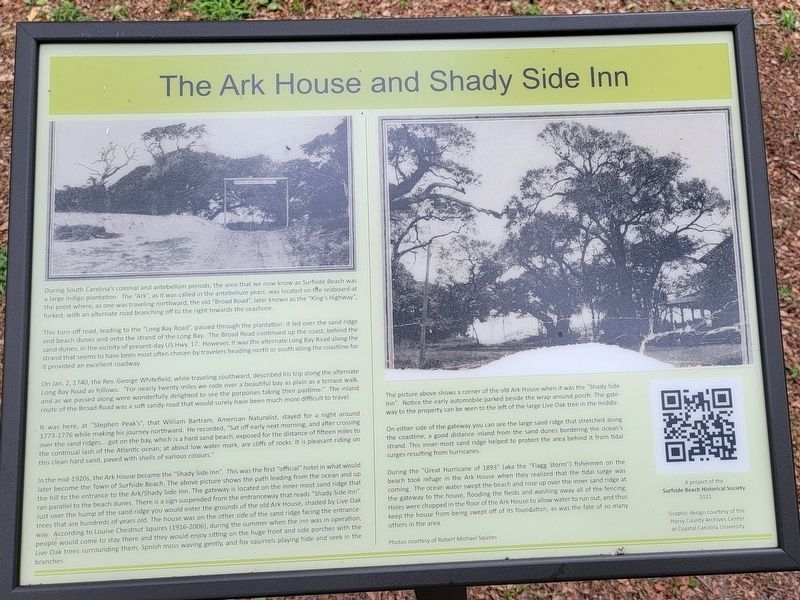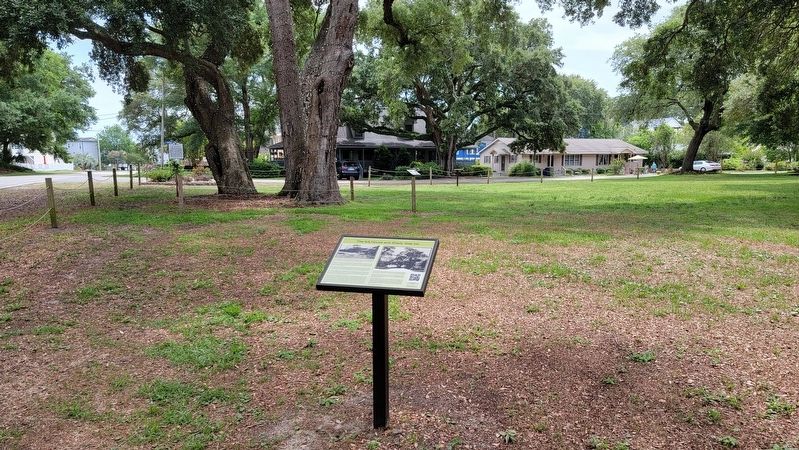Myrtle Beach in Horry County, South Carolina — The American South (South Atlantic)
The Ark House and Shady Side Inn
During South Carolina's colonial and antebellum periods, the area that we now know as Surfside Beach was a large indigo plantation. The "Ark", as it was called in the antebellum years, was located on the seaboard at the point where, as one was traveling northward, the old "Broad Road", later known as the "King's Highway", forked, with an alternate road branching off to the right towards the seashore.
This turn-off road, leading to the "Long Bay Road", passed through the plantation. It led over the sand ridge and beach dunes and onto the strand of the Long Bay. The Broad Road continued up the coast, behind the sand dunes, in the vicinity of present-day US Hwy. 17. However, It was the alternate Long Bay Road along the strand that seems to have been most often chosen by travelers heading north or south along the coastline for it provided an excellent roadway.
On Jan. 2, 1740, the Rev. George Whitefield, while traveling southward, described his trip along the alternate Long Bay Road as follows: "For nearly twenty miles we rode over a beautiful bay as plain as a terrace walk, and as we passed along were wonderfully delighted to see the porpoises taking their pastime." The inland route of the Broad Road was a soft sandy road that would surely have been much more difficult to travel.
It was here, at "Stephen Peak's", that William Bartram, American Naturalist, stayed for a night around 1773-1776 while making his journey northward. He recorded, "Sat off early next morning, and after crossing over the sand ridges... got on the bay, which is a hard sand beach, exposed for the distance of fifteen miles to the continual lash of the Atlantic ocean; at about low water mark, are cliffs of rocks. It is pleasant riding on this clean hard sand, paved with shells of various colours."
In the mid-1920s, the Ark House became the "Shady Side Inn". This was the first "official" hotel in what would later become the Town of Surfside Beach. The above picture shows the path leading from the ocean and up the hill to the entrance to the Ark/Shady Side Inn. The gateway is located on the inner-most sand ridge that ran parallel to the beach dunes. There is a sign suspended from the entranceway that reads "Shady Side Inn". Just over the hump of the sand ridge you would enter the grounds of the old Ark House, shaded by Live Oak trees that are hundreds of years old. The house was on the other side of the sand ridge facing the entranceway. According to Louise Chestnut Squires (1916-2006), during the summer when the inn was in operation, people would come to stay there and they would enjoy sitting on the huge front and side porches with the Live Oak trees surrounding them, Spnish moss waving gently, and fox squirrels playing hide and seek in the branches.
The picture above shows a corner of the old Ark House when it was the "Shady Side Inn". Notice the early automobile parked beside the wrap-around porch. The gateway to the property can be seen to the left of the large Live Oak tree in the middle.
On either side of the gateway you can see the large sand ridge that stretched along the coastline, a good distance inland from the sand dunes bordering the ocean's strand. This inner-most sand ridge helped to protect the area behind it from tidal surges resulting from hurricanes.
During the "Great Hurricane of 1893" (aka the "Flagg Storm") fishermen on the beach took refuge in the Ark House when they realized that the tidal surge was coming. The ocean water swept the beach and rose up over the inner sand ridge at the gateway to the house, flooding the fields and washing away all of the fencing. Holes were chopped in the floor of the Ark House to allow water to run out, and thus keep the house from being swept off of its foundation, as was the fate of so many others in the area.
Photos courtesy of Robert Michael Squires
Erected 2021 by Surfside Beach Historical Society.
Topics. This historical marker is listed in these topic lists: Disasters • Roads & Vehicles. A significant historical date for this entry is January 2, 1740.
Location. 33° 36.337′ N, 78° 58.576′ W. Marker is in Myrtle Beach, South Carolina, in Horry County. Marker is at the intersection of 3rd Avenue South and South Willow Drive, on the right when traveling south on 3rd Avenue South. Touch for map. Marker is in this post office area: Myrtle Beach SC 29575, United States of America. Touch for directions.
Other nearby markers. At least 8 other markers are within 4 miles of this marker, measured as the crow flies. The Ark Sand Ridge (a few steps from this marker); Ark Agriculture (within shouting distance of this marker); Ark Plantation (within shouting distance of this marker); 1838 Ark Land Survey (within shouting distance of this marker); Surfside Beach Veterans Monument (approx. 0.2 miles away); Ark Cemetery (approx. 0.2 miles away); Jack Walker (approx. 3.6 miles away); St. James Rosenwald School (approx. 3.9 miles away). Touch for a list and map of all markers in Myrtle Beach.
Also see . . . Surfside Beach History. Town website entry (Submitted on June 7, 2022, by Michael Herrick of Southbury, Connecticut.)
Credits. This page was last revised on December 15, 2023. It was originally submitted on June 7, 2022, by Michael Herrick of Southbury, Connecticut. This page has been viewed 172 times since then and 26 times this year. Photos: 1, 2. submitted on June 7, 2022, by Michael Herrick of Southbury, Connecticut.

